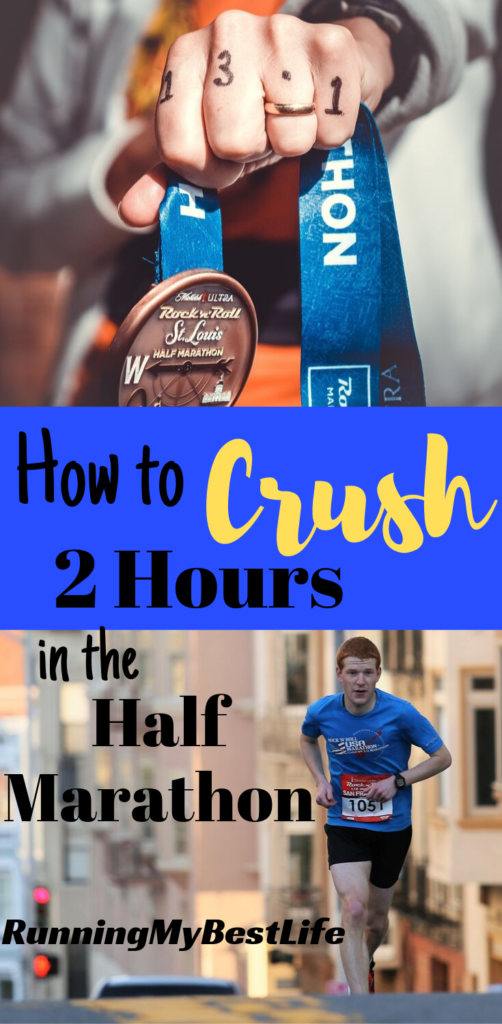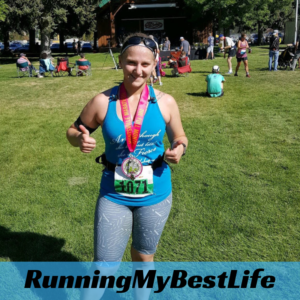The 2-Hour half marathon goal. For some reason, the 2-hour half marathon is one of the most common time goals I see among recreational runners.
2 Hours seems to be the magical number to make us feel like real runners. (Side note: You ARE already a real runner! If you don’t believe me, then you need to read this)
Running a half marathon in 2 hours is a serious time goal for many runners. If you can break the 2-hour mark, you really can’t call yourself a slow runner anymore!
The actual difficulty of achieving a 2-Hour half marathon is dependent on each runner and several factors including age, weight, current running ability, body type, past running experience, nutritional habits, training methods, and much more.
Some people (like my husband) can go out and run a sub 2-hour half marathon without much training at all. The rest of us (like myself) have to work really freaking hard to develop the fitness capacity to sustain a pace fast enough to run a sub 2-hour half marathon without dying!!
In this post, I’m going to guide you through the different factors you need to improve that will help get you to your 2-hour half marathon goal including how to calculate pace, what key workouts to include in your training plan, how to avoid injury, and how to fuel your body effectively.

What Pace is a 2-Hour Half Marathon?
First, we need to address the obvious: a 2-hour half marathon requires an average pace of 9:09 minutes per mile. Whether this is an easy pace or a ridiculously impossible pace will be COMPLETELY DIFFERENT for different runners! As I mentioned already, the actual difficulty is dependent on many different factors.
For some people, it might be pretty easy. But if you’re reading this, I’m willing to bet you’re more like me and this is goal is a significant challenge for you.
Let’s talk about ways to get faster so you can hold the pace you need to break the 2-hour half marathon mark.
How to Get Faster to Meet the 2-Hour Half Marathon Goal Pace
When I trained seriously to achieve my 2-hour half marathon goal, I incorporated four key elements into my plan that helped improve my speed:
- Quality Nutrition
- Hill Training
- Speed Work
- Strength Training
1. Quality Nutrition
I’m going to be blunt about this one: a fad diet won’t fuel you to your best race. It just won’t. A fad diet might help you lose weight in the short term but combining a calorie deficit with a hard training workload is a recipe for disaster. To maximize the positive effects of your training and help your body absorb the stress load, you need to eat ENOUGH, HIGH QUALITY food.
Best-selling author, running coach, and sports nutritionist Matt Fitzgerald recommends 5 key nutrition habits for endurance runners:
- Eat Everything: Don’t exclude certain food groups on purpose. A variety of foods helps us get the variety of nutrients we need for optimal health.
- Eat Quality: Focus the majority of your food on high quality nutritional value. Get the most value out of the calories you consume.
- Eat Carb-Centered: Carbs are not the enemy, they actually help our bodies absorb the impact of training and fuel our workouts. Elite endurance athletes focus their meals around carbohydrates for optimal performance.
- Eat Enough: A calorie deficit will not help you attain your best performance. Make sure you are taking enough fuel in to support your training and recovery.
- Eat Individually: Tailor your eating habits to your individual preferences because ultimately, it will be much easier to stick to an eating plan if you enjoy the foods you’re eating!
Related: 5 Important Nutrition Habits for Endurance Athletes
Additionally, you’re going to need to learn what to eat before, during, and after your half marathon for the best results. You can find a comprehensive guide in The Complete Nutrition Guide on How to Fuel a Half Marathon.
[convertkit form=876847]
2. Hill Training
Before I got serious about achieving my 2-hour half marathon goal, I HATED hills. I pretty much avoided them, because they sucked. Every time I encountered a hill on my runs, my legs would burn, my lungs would burst, and my pace would slow to a crawl.
Then, I started to get intentional about running hills on purpose. I sought them out on my longer runs, and I incorporated hill sprint repeats as a speed workout every other week alternating with my track workouts.
And holy smokes…now I can power up hills like nobody’s business, churning them out at the same pace or close to my flat pace. Plus, training on hills gave me the confidence to tackle the hills during my race with ease.
3. Speed Work
Speed work was huge. My goal race pace was significantly faster than my easy run pace, so I had to train my body to run faster. Speed work is the way to accomplish this. They helped improve my form, my running economy (running faster with less effort), familiarized my body with goal pace effort, and helped me learn to tolerate discomfort.
Specifically, two types of speed workouts made a huge difference in my training plan:
- Track Repeats: A set number of repetitions of a certain distance at different goal race paces. They could be 200 meters, 400m, 800m, or even 1600m. Shorter distance repeats are run at faster paces, while a 1600m repeat might be run at your goal half marathon pace.
- Tempo Runs: These runs start off slow, gradually build the pace and hold it at or above your race pace for the middle part of the run, and then slowly back the pace down to finish at an easy cooldown pace. The tempo run is designed to help your body improve its lactate threshold and tolerate a hard effort for longer.
I incorporate 2 speed workouts per week, along with 2 easy runs and 1 long run at a slow pace.
Related: 3 Killer Speed Workouts to Skyrocket Your Race Day Confidence
4. Strength Training
Besides running, one of the most influential things you can do to increase your speed is to incorporate strength training. Runners need leg day too!
When I started getting serious about my strength training again, I started hitting PR after PR. I dropped my 5k personal best from 28:00 in February to 26:20 in June, and then 25:34 in August! That’s a huge difference, and it’s largely due to dedicated strength training.
If you’re struggling to increase your pace and you aren’t doing regular strength training (with weights!) yet, then this is your next step. Incorporate 2-3 strength sessions per week. You can do a 30 minute strength session either before or after one of your shorter run days.
Personally, I choose to do leg day right after my track workout, and my upper body strength and core day either before or after an easy run during the week.
Strength training is also ESSENTIAL to injury prevention!!
Related: Why Runners Need Strength Training + 2 Tips for Success
[convertkit form=1015226]
Finalize Each Element of Your Race Day Plan to Run a Half Marathon in 2 Hours
After you train for 12+ weeks to finally achieve your goal of breaking the 2-hour half marathon, you need to have a plan for everything to come together on race day.
Here are 6 must-have components for your race day plan:
- Race Morning and Post-Race Logistics: Don’t let a lack of parking prevent you from getting to the start and warmed up on time!
- Race Morning Breakfast: What you eat in the hours before your half marathon can make or break your race by fueling you to your best day or ruining your day with stomach distress.
- Pre-Race Warm-Up Routine: Practice your warm-up to make sure your body is ready to run and perform it’s best as soon as you cross the starting line.
- Plan Your Pace, Then Execute: Should you run the same pace the entire time, start slow and finish fast, or start fast and hold onto your pace for as long as possible?
- Race Nutrition: Figure out what fuel to use during the race, when to take it, and how much you need.
- Plan Your Race Recovery: After you cross the finish line, have a plan to help your body recover so you don’t feel like you got hit by a bus the next morning.
Related: How to Develop a Fail-Proof Race Day Plan

Are you ready to run your best half marathon yet?
I cover all of these topics in-depth in my course, “12 Weeks to Your First Half Marathon” as I guide novice runners through all of the elements needed to bring their race day together.
If you’re not ready for the full course yet, you can get started with my FREE 6-Day intro course on how to get started training for your half marathon.
The kick-start course will set you up with everything you need to get your training started including a workout tracker, training plan recommendations, and mindset training.
[convertkit form=964110]
Are you working towards a 2-Hour Half Marathon? If you’ve already achieved it, what advice would you give to other runners?

Run Happy,
Alexis
- Nailing Your Marathon Hydration Strategy: A Comprehensive Guide
- Conquering Marathons in the Cold: A Comprehensive Guide
- Harnessing the Power of Technology for Successful Marathon Training
- Mastering the Marathon: The Ultimate Guide to Nutrition and Training
- Ultimate Guide to the Top 5 Running Shoes for Beginners in 2023
About Me: I’m Alexis, Founder of RunningMyBestLife! I am an avid recreational runner, half marathoner, wife, dog mom, busy professional, downhill skier in Northern Utah. My mission is to help new enthusiasts fall in love with the sport of running. I believe that running is a catalyst to taking control of your life and living your best life by design. Learn More –>